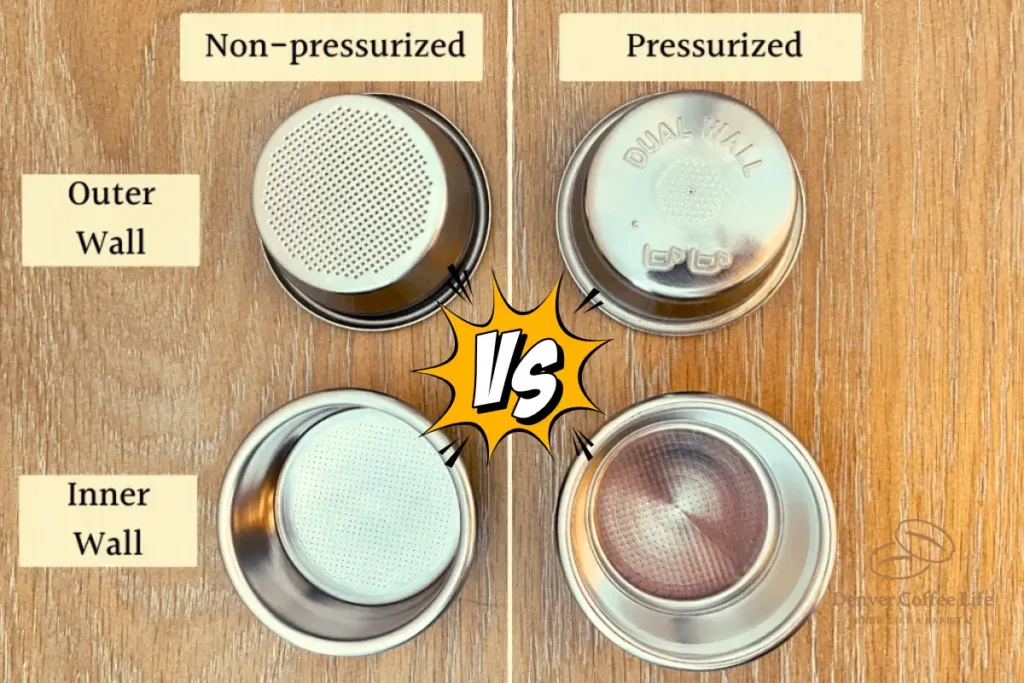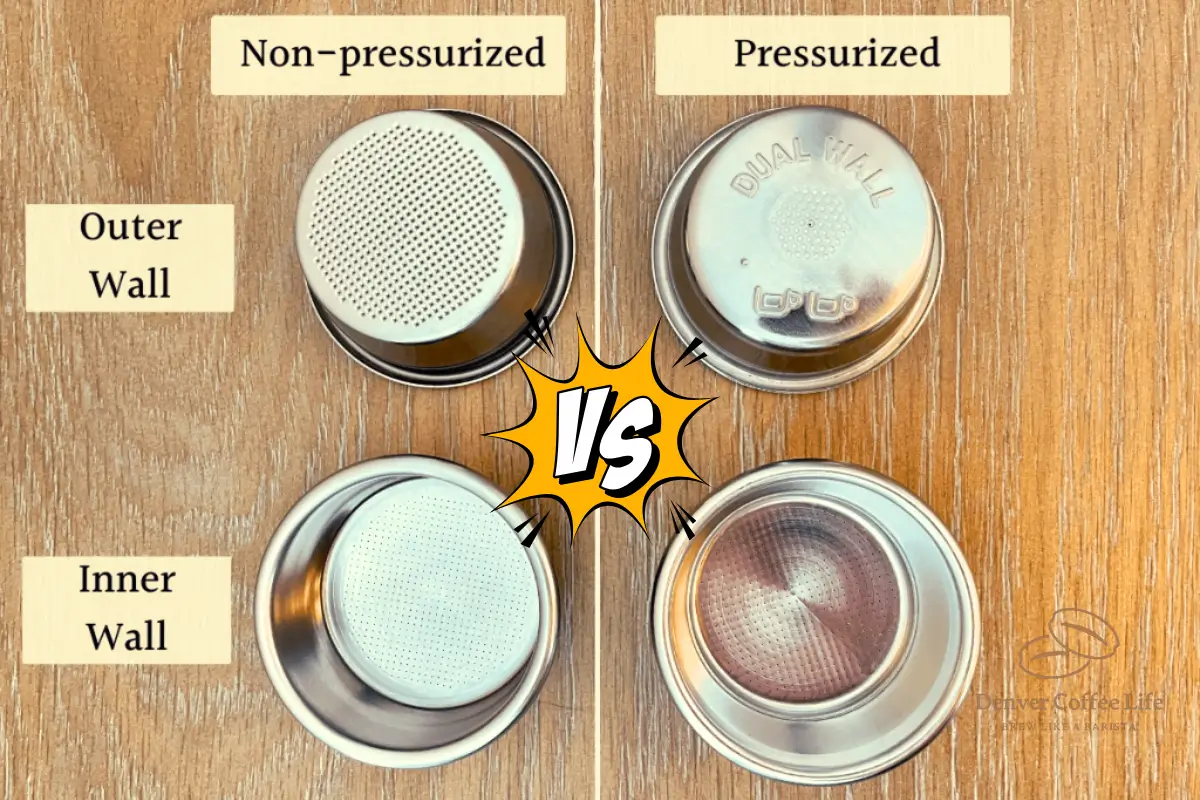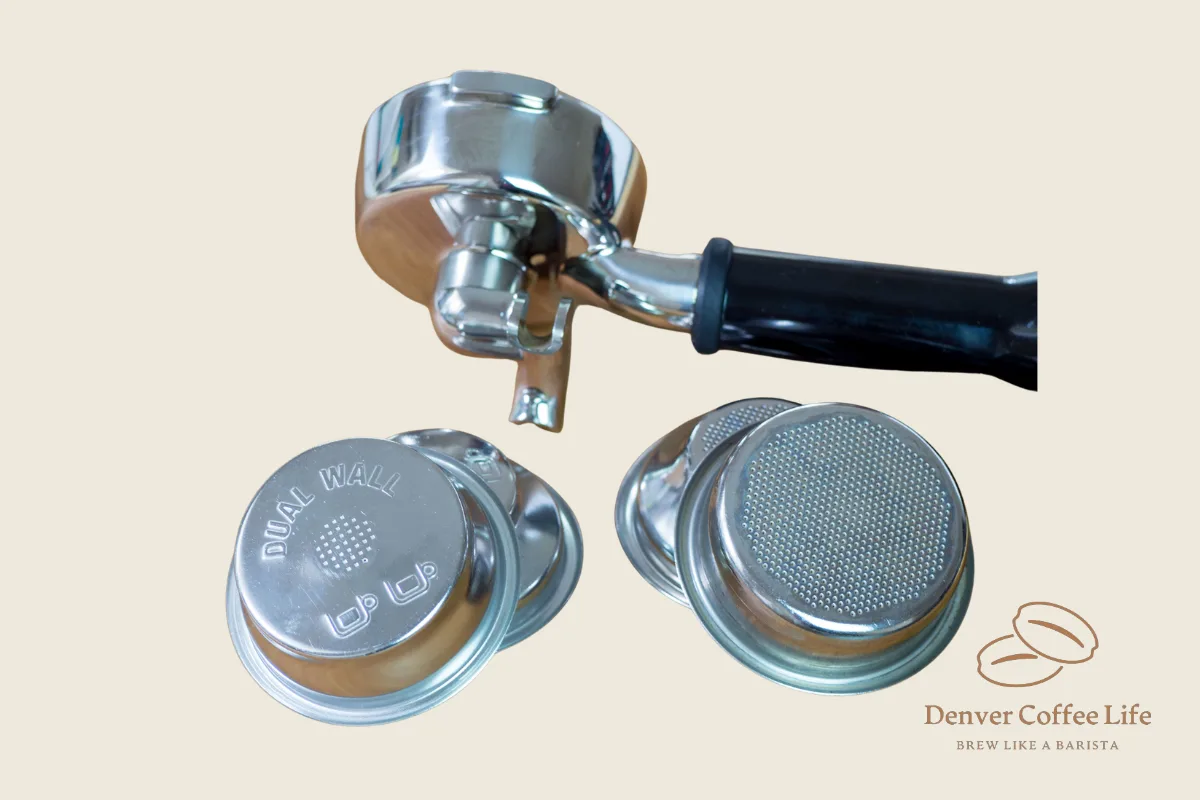Choosing the right portafilter can impact your coffee’s taste. Pressurized and non-pressurized portafilters offer different brewing experiences.
Understanding these differences helps coffee lovers find their perfect brew. Portafilters are essential tools for espresso machines. They hold the coffee grounds and affect the extraction process. A pressurized portafilter is designed to create a consistent flow by controlling pressure.
It is often recommended for beginners or those using pre-ground coffee. On the other hand, a non-pressurized portafilter allows more control over the extraction. It is favored by experienced baristas who grind their own beans. Comparing these portafilters can help you choose one that matches your skill level and taste preference. Exploring their features and benefits provides insights into how each can enhance your coffee experience.
Introduction To Portafilters
Welcome to the fascinating world of portafilters. If you’ve ever tried to make espresso, you’ve encountered this crucial tool. It’s the small basket that holds coffee grounds in the espresso machine. Simple, right? However, the type of portafilter you use can significantly impact your coffee experience. Whether you’re a seasoned barista or a home brewer, understanding portafilters is essential to crafting the perfect cup.
Espresso Basics
Espresso is a coffee brewing method where hot water is forced through finely-ground coffee. It’s known for its rich flavor and crema on top. But achieving that perfect shot requires precision. The grind size, water temperature, and pressure all play a role. The portafilter is the bridge between the coffee grounds and the espresso machine. It helps control the extraction process, making it vital for espresso lovers.
Have you ever wondered why your espresso tastes different from one machine to another? The portafilter could be the reason. Different types can alter the pressure and extraction, changing the taste. It’s not just about the beans or the machine; it’s also about what holds the grounds.
Role Of Portafilters
The portafilter is more than just a holder. It influences the pressure applied to coffee grounds. Pressurized portafilters are forgiving, ideal for beginners. They help create crema even if the grind or tamp isn’t perfect. Non-pressurized portafilters, however, require skill and precision. They allow for more control over the extraction process.
Imagine you’re trying to improve your espresso skills. A non-pressurized portafilter can be challenging but rewarding. It forces you to pay attention to grind size and tamping. But the results can be spectacular. You can taste the layers of flavor and complexity in each sip.
Do you prefer experimenting with coffee techniques? A non-pressurized portafilter offers flexibility. You can tweak variables to suit your taste. On the other hand, if consistency is your goal, a pressurized portafilter can help achieve that. It simplifies the process, making it easier to replicate results.
So, which type suits your coffee journey? Consider your skills and preferences. Are you willing to take on the challenge, or do you prefer a straightforward approach? Both portafilters have their place, and the choice is yours.
Pressurized Portafilter Features
Pressurized portafilters are ideal for beginners, ensuring consistent coffee extraction. They create perfect crema with less effort. Non-pressurized portafilters require skill, offering more control over the brewing process.
When brewing coffee at home, the type of portafilter you use can make a significant difference in your espresso experience. A pressurized portafilter might be just what you need if you’re looking for convenience and consistency. This tool is designed to simplify the brewing process, making it a great choice for beginners or those who want a hassle-free coffee routine.
Design And Functionality
The design of a pressurized portafilter is all about ease of use. It has a dual-wall basket with a small exit hole, which helps maintain consistent pressure during brewing. This design allows it to compensate for mistakes like uneven tamping or incorrect grind size, giving you a more forgiving coffee-making experience. Functionality-wise, the pressurized portafilter is like a supportive friend. It takes the guesswork out of brewing. Even with suboptimal conditions, it can still produce a decent crema on your espresso.
Pros And Cons
Using a pressurized portafilter comes with several benefits. Pros include: – Consistency: It delivers uniform results even if your technique isn’t perfect. – Ease of use: Ideal for beginners, it simplifies the brewing process. – Low maintenance: Less need for precise grinding and tamping. However, it’s not without its drawbacks. Cons include: – Limited control: You might miss out on experimenting with different brewing techniques. – Flavor potential: The quality might not match that of a non-pressurized portafilter in skilled hands. Have you ever wished for a quick and easy espresso without the fuss? A pressurized portafilter could be your answer, but remember, it’s all about what suits your coffee journey. Would you prefer control and complexity, or are convenience and consistency your top priorities? Your choice will guide your perfect cup.
Non-pressurized Portafilter Traits
The non-pressurized portafilter is ideal for coffee enthusiasts. It allows complete control over the coffee extraction process. This type requires skill and understanding to produce the perfect espresso shot. Let’s explore its unique traits in detail.
Structure And Mechanism
The non-pressurized portafilter has a simple design. It lacks built-in pressure systems. Instead, it relies on the barista’s skills. The filter basket is open, which means water flows naturally. This design means grind size and tamping are crucial. The barista must ensure an even water flow for great coffee.
Advantages And Disadvantages
The main advantage is control. It allows customization of extraction time and flavor. A skilled barista can create a unique coffee experience. Another benefit is the enhanced flavor profile. More oils and aromas are extracted with precision.
But there are challenges. It demands precision and patience. Beginners may struggle without proper training. Inconsistent results may occur if the technique is flawed. It also requires a good-quality grinder for optimal grind size.
Taste And Quality Comparison
If you’re a coffee lover, you’ve probably wondered about the impact of using a pressurized versus non-pressurized portafilter on your espresso’s taste and quality. The choice between these two can transform your coffee experience, affecting flavor profiles and crema. Your espresso journey is about to get interesting as we dive into the delicious details.
Flavor Profiles
Pressurized portafilters can be a game-changer for beginners. They make espresso brewing easier by compensating for uneven grinds and tamping. The result? A consistent flavor that suits those who prefer a straightforward taste.
But if you’re chasing complexity, the non-pressurized option is your ticket. It demands precision but rewards you with nuanced flavors. You’ll taste the distinctive notes of different beans, allowing your palate to explore new dimensions.
Have you ever sipped a cup and felt it lacked something? Perhaps it’s time to experiment with the non-pressurized method and discover if it’s the missing link to flavor depth.
Crema Differences
Crema is the golden crown of any espresso shot. It’s the first thing you see and a major player in your coffee’s aroma and texture. Pressurized portafilters produce a thicker, foamy crema, often appealing visually. Yet, it can mask the coffee’s true character.
Non-pressurized portafilters might offer a thinner crema, but it’s more authentic to the beans. This can be a revelation, especially when you seek to appreciate the coffee’s genuine essence.
Imagine serving espresso to friends and watching their expressions. Would you prefer them to savor the coffee’s soul or simply admire the surface? Your choice of portafilter could make that difference.
User Experience
Choosing between pressurized and non-pressurized portafilters impacts your coffee experience. Pressurized portafilters simplify brewing, offering consistency. Non-pressurized ones allow more control, which is ideal for those who enjoy experimenting with flavors.
The journey of making a perfect espresso at home can be both rewarding and challenging. Your choice of portafilter—pressurized or non-pressurized—plays a significant role in your overall user experience. Understanding the differences can help you make an informed decision that aligns with your personal preferences and skill level. Let’s dive into what each type of portafilter offers in terms of user experience. ###
Ease Of Use
If you’re new to espresso-making, a pressurized portafilter might be your best friend. It simplifies the process by compensating for less-than-perfect grind size and tamping pressure. This means you can achieve a decent shot without mastering every aspect of espresso preparation. On the other hand, a non-pressurized portafilter demands more precision.
You’ll need to focus on grind size, distribution, and tamping to get the best results. But don’t let this intimidate you. With practice, this can become second nature and even enjoyable. Think about what makes you more comfortable and confident. Do you prefer a straightforward experience, or are you ready for a bit of a challenge? Your choice will shape how you interact with your espresso machine daily. ###
Skill Level Required
A pressurized portafilter is perfect for beginners. It forgives small mistakes and still delivers a satisfying espresso shot. You don’t need to have barista-level skills to start enjoying your espresso. In contrast, a non-pressurized portafilter is like a blank canvas for coffee enthusiasts. It allows for more control over the extraction process, which can lead to a superior espresso shot.
However, this requires a willingness to learn and practice different techniques. Are you eager to hone your espresso skills, or do you value convenience above all? Recognizing your current skill level can guide you in choosing the right portafilter. Whether you opt for ease or a learning curve, each choice offers its unique advantages. What’s important is finding the right balance for your taste and lifestyle.
Maintenance And Durability
When choosing between a pressurized and non-pressurized portafilter, maintenance and durability play a crucial role. Understanding these aspects helps in making a wise decision. Proper care ensures the longevity and performance of your espresso machine. Each type of portafilter has its own cleaning needs and long-term performance considerations. Let’s explore these aspects in detail.
Cleaning Needs
Pressurized portafilters require less frequent cleaning. Their design helps reduce coffee residue buildup. This makes them easier to maintain. A simple rinse after each use often suffices. Occasionally, a deeper clean keeps it in top condition.
Non-pressurized portafilters need more attention. Coffee grounds can clog the basket’s tiny holes. Regular scrubbing ensures optimal performance. Use a brush or a specialized cleaner for thorough cleaning. This helps maintain the quality of your espresso.
Long-term Performance
Durability varies between the two types. Pressurized portafilters tend to last longer. Their simpler design means fewer parts can wear out. They maintain consistent performance over time.
Non-pressurized portafilters offer a different experience. They require skill and practice to master. With proper care, they provide excellent long-term results. Regular maintenance ensures they deliver rich and flavorful espresso.
Consider your lifestyle and coffee-making habits. This will guide you in choosing the right portafilter for you. Remember, regular maintenance extends the life and performance of your machine.
Cost And Accessibility
Pressurized portafilters are often more affordable and easier to use, suitable for beginners. Non-pressurized options require skill and are typically pricier, offering more control for experienced users. Both options vary in accessibility, catering to different levels of expertise and budget constraints.
When choosing between a pressurized and non-pressurized portafilter, cost and accessibility often become deciding factors. Understanding the price range and availability can guide you toward a decision that fits both your budget and coffee-making needs. Let’s dive into these aspects to help you make an informed choice.
Price Range
Pressurized portafilters are generally more budget-friendly. You can find them in espresso machines that cater to beginners or those who prefer convenience over control. These machines often fall within the lower to mid-price range, making them accessible if you’re just starting your espresso journey. On the other hand, non-pressurized portafilters tend to be associated with higher-end espresso machines.
They are designed for those who want more control over their espresso extraction process. Although they might require a larger initial investment, they offer the potential for superior coffee quality. If you’re considering costs, think about how much you’re willing to spend upfront versus the long-term benefits. Is it worth spending more now for a potentially richer coffee experience?
Availability In Market
Pressurized portafilters are widely available and can be found in most entry-level to mid-range espresso machines. These are often stocked in large electronic stores and online marketplaces, making them easy to find. In contrast, non-pressurized portafilters are more common in specialized coffee equipment stores. They are popular among coffee enthusiasts who appreciate the challenge and reward of perfecting their espresso craft. If you live in a city with a vibrant coffee culture, you might find a wider selection of non-pressurized options locally.
Alternatively, online shopping offers a vast array of choices, but consider shipping costs and potential delays. Have you ever been frustrated by a lack of options in your local area? Exploring online resources might open up a world of possibilities you hadn’t considered. Navigating the cost and accessibility of these portafilters can influence your espresso-making experience. Reflect on what matters most to you—price, availability, or the quality of your brew.
Which Is Right For You?
Deciding between a pressurized or non-pressurized portafilter can be puzzling. Each type serves different needs and preferences. Understand what each offers to make the right choice. Learn how your coffee habits can guide your decision.
Choosing Based On Preferences
Think about your daily coffee needs. Do you love experimenting with coffee flavors? A non-pressurized portafilter might suit you. It allows greater control over the brewing process. Adjust grind size and tamp pressure for varied flavors.
If you prefer a quick and easy brew, consider a pressurized portafilter. It’s forgiving with grind size variations. This type often produces a consistent shot, ideal for beginners or those short on time.
Making An Informed Decision
Research is key before choosing a portafilter. Understand the pros and cons of each type. Non-pressurized portafilters offer more control but require skill. Pressurized ones are user-friendly but limit flavor exploration.
Consider your coffee machine compatibility. Not all machines support both types. Check machine specifications to avoid compatibility issues. Invest time in learning about your machine and portafilter options. This ensures a satisfying coffee experience tailored to your needs.
Frequently Asked Questions
Should I Use Pressurized Or Non Pressurized Portafilter?
Choose a pressurized portafilter for ease and consistency in espresso making. It’s ideal for beginners. Opt for a non-pressurized portafilter for more control and flavor complexity. Experienced baristas often prefer it. Consider your skill level and desired coffee taste when deciding.
Is Pressurised Portafilter Better Than Bottomless?
A pressurized portafilter is easier for beginners, offering consistent results. A bottomless portafilter provides better control and insight into extraction. Your choice depends on skill level and preference.
What Is The Difference Between Pressurised And Non Pressurised Espresso Baskets?
Pressurized espresso baskets create crema easily, ideal for beginners. Non-pressurized baskets require skill, offering better flavor control.
How Do I Know If My Portafilter Is Pressurized?
Check for a spring mechanism inside the portafilter. Pressurized portafilters typically have an internal spring or valve. They create more resistance, resulting in a consistent espresso shot. Non-pressurized portafilters lack these features, allowing for manual control over the extraction process.
Conclusion
Choosing the right portafilter impacts your coffee experience. Pressurized portafilters offer convenience and consistency. Perfect for beginners or casual coffee drinkers. Non-pressurized portafilters provide greater control. Ideal for those seeking richer flavors. Consider your skill level and desired taste. Both types have unique benefits.
Decide what suits your needs best. Enjoy experimenting with your coffee journey. Remember, the perfect brew depends on personal preference. Happy brewing and savoring your coffee moments!




